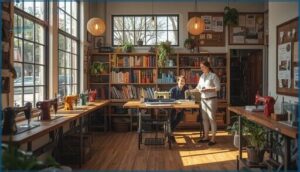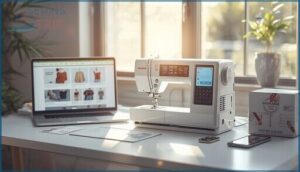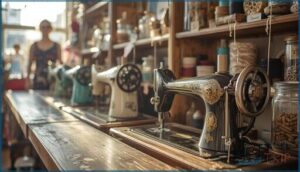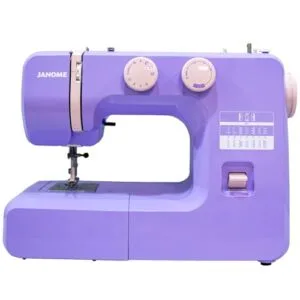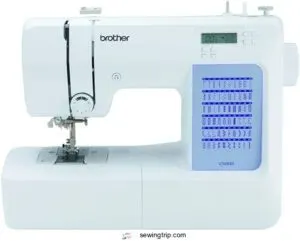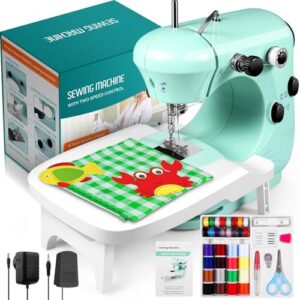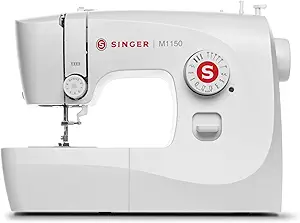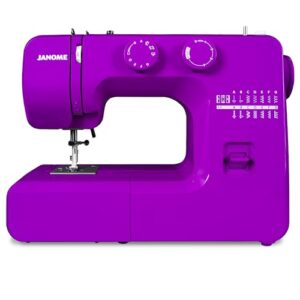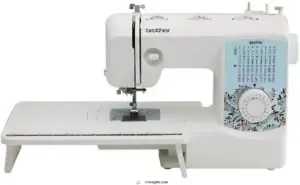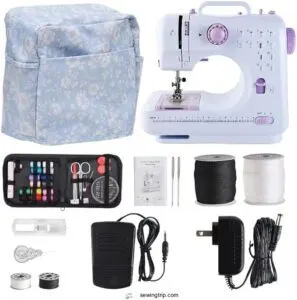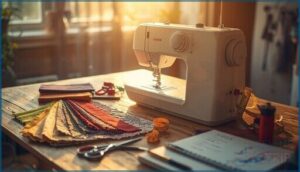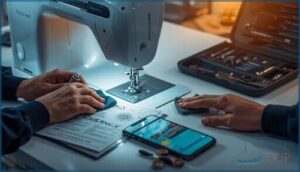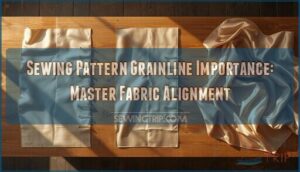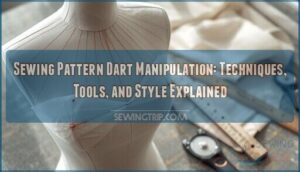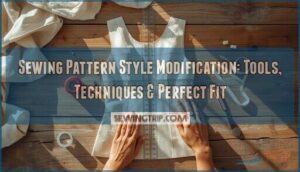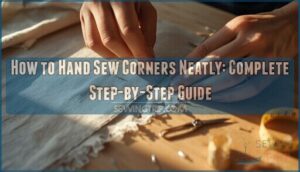This site is supported by our readers. We may earn a commission, at no cost to you, if you purchase through links.

You’ve narrowed down the perfect sewing machine model, saved up your budget, and you’re ready to hit “buy”—but then you pause. Where should you actually buy this thing? The answer matters more than you might think.
Walk into a local retailer and you’ll test drive machines before committing, but browse online and you’ll find models that never hit store shelves. Buy direct from the manufacturer and you might access customization options, while thrift shops hide vintage machines at half the retail price.
Each buying route opens different doors—and closes others. Your choice shapes not just what you pay, but whether you’ll get hands-on training, solid warranty coverage, and the exact machine that matches your creative vision.
Table Of Contents
- Key Takeaways
- Where to Buy Sewing Machines
- Top 10 Sewing Machines to Buy
- 1. Brother Lightweight Sewing Machine Model
- 2. Janome Lovely Lilac Sewing Machine
- 3. Brother Computerized Sewing Machine Model
- 4. Portable Mini Sewing Machine Kit
- 5. Portable Sewing Machine For Home
- 6. Brother Computerized Sewing and Quilting Machine
- 7. Janome Easy Sewing Machine Model
- 8. Brother Sewing And Quilting Machine
- 9. Portable Sewing Machine For Beginners
- 10. Portable Sewing Machine Kit
- Factors to Consider Before Buying
- Tips for Buying Used Sewing Machines
- Support, Maintenance, and Warranties
- Frequently Asked Questions (FAQs)
- Conclusion
Key Takeaways
- Where you buy your sewing machine matters as much as which model you choose—local retailers offer hands-on testing and training, while online marketplaces provide a wider selection and competitive pricing (often 10% below retail).
- Match your purchase to your skill level: beginners need simple machines under $300 with 10-25 stitches, while experienced sewers should invest in computerized models with 50-100+ stitches and specialized features like embroidery or quilting capabilities.
- Always factor in post-purchase support before buying—manufacturer warranties typically cover mechanics for 25 years but electronics for only 1-6 years, and access to repair services, replacement parts, and customer support can make or break your long-term experience.
- Test before you commit whenever possible, inspect used machines thoroughly for wear and hidden repair costs, and prioritize dealers who offer return windows, warranty coverage, and classes that’ll help you actually master your investment.
Where to Buy Sewing Machines
You’ve got more options than you might think regarding buying a sewing machine. Whether you prefer browsing in person or shopping from your couch, each route has its own perks worth considering.
Let’s look at where you can find the right machine for your needs.
Local Sewing Machine Retailers
Local sewing machine retailers offer something online shopping can’t match: hands-on test drives before you buy. Over 3,200 independent shops across the U.S. give you real expertise, with staff satisfaction ratings hitting 4.8 out of 5.
You’ll find machine repair services, local workshops, and a thriving sewing community that builds genuine customer loyalty. Most stock spare parts for rapid fixes, keeping your creative momentum rolling strong.
For complex tasks, consider visiting a local sewing shop for professional guidance and support.
Online Marketplaces
Online marketplaces like Amazon, eBay, and Etsy give you access to over 150 home sewing machine models from 20+ countries. Digital sales channels grew 6.45% annually, with 5.6 million units purchased online in 2023. You’ll find computerized models averaging $450–$1,200, often 10% below retail.
Online reviews help decode buyer behavior and market trends, though you’re trading hands-on testing for convenience and competitive pricing.
The growth of the sewing machines market is driven by increasing demand for smart sewing technology.
Manufacturer Websites
Buying directly from manufacturer websites like Brother, BERNINA, and Janome puts you in control. You’ll get machine customization options, product filtering by skill level, and online support that most third-party sellers can’t match.
Direct sales accounted for 78% of total sewing machine revenue in 2024. Warranty options run stronger here too—usually one-year mechanical coverage, handled through authorized service centers at no extra cost.
Craft and Fabric Stores
Craft and fabric stores give you hands-on access before you buy. You’ll find machine demonstrations, sewing classes, and customer service that actually knows the difference between a walking foot and a zipper foot.
Store layout puts sewing machines alongside fabric selection and sewing accessories, so you can grab thread and supplies in one trip.
The quilt shop vibe builds a real sewing community and support you won’t find scrolling online.
Thrift Stores and Secondhand Shops
Thrift stores and secondhand shops offer hidden gems where refurbished machines and vintage models sell for 40-60% less than retail. You’ll spot Singer, Brother, and Kenmore sewing equipment most often, with prices ranging from $35-$70 for entry-level home sewing products.
Check secondhand prices carefully—pre-1980s metal-bodied machines often outperform newer plastic models. Smart thrift shopping means inspecting resale values before you commit.
Top 10 Sewing Machines to Buy
You’ve got options, and that’s the good news. The machines below range from lightweight portables to full-featured computerized models, so there’s something here whether you’re stitching hems or tackling quilts.
Let’s break down the top 10 models that consistently deliver for sewers at every level.
1. Brother Lightweight Sewing Machine Model
If you’re just starting out or need something you can tuck away easily, the Brother XM2701S deserves your attention. At $129.99, this lightweight sewing machine delivers 27 built-in stitches and weighs only 12.6 pounds—perfect for moving from room to room.
Brother sewing machines consistently earn high marks for reliability, and this model includes an automatic needle threader and six essential machine accessories. You’ll handle everything from basic hemming to decorative stitches without breaking the bank. Brother models like this one offer serious value in sewing machine sales.
Best For: Beginners and hobbyists who want an affordable, portable machine that handles everyday sewing projects without overwhelming features.
- Lightweight at 12.6 pounds with 27 built-in stitches, making it easy to store and move while offering enough variety for most projects.
- Automatic needle threader and one-step buttonholer save time and frustration, especially helpful for new sewers still learning the basics.
- Excellent value at $129.99 with six included feet and a free arm for sleeves and cuffs—you get a lot without spending much.
- Some users report skipped stitches and inconsistent stitch quality, which can be frustrating during detailed work.
- Struggles with thick fabrics or multiple layers, getting noisy and potentially jamming when pushed beyond light to medium materials.
- Side-loading bobbin design requires careful threading to avoid jams, and the machine only works with US 120-volt power or the warranty’s void.
2. Janome Lovely Lilac Sewing Machine
You’ll appreciate the Janome Lovely Lilac if you want a no-nonsense sewing machine that masters fabric selection challenges with confidence. At $129, this full-sized workhorse delivers 15 built-in stitch patterns and a heavy-duty metal frame that manages everything from lightweight cottons to multiple denim layers.
The four-step buttonhole and front-loading bobbin system simplify sewing machine maintenance, while the 25-year warranty backs your investment. Thread choices expand easily with dual spool pins, making this model ideal for garment sewing and home décor projects alike.
Best For: Beginners and budget-conscious sewers who want a reliable, versatile machine that handles basic to intermediate projects without breaking the bank.
- Heavy-duty metal frame and internal construction provide stability and durability for working with thick fabrics like denim and multiple layers.
- Excellent value at $129 with 15 built-in stitches, four presser feet, and a 25-year limited warranty that protects your investment.
- Easy threading and front-loading bobbin system make setup quick and frustration-free, especially for those new to sewing.
- The bright pink “Lovely Lilac” color isn’t for everyone and some users find it looks cheaper than they expected.
- Plastic dual spool pins feel flimsy compared to the metal frame, and there’s no option to adjust needle positioning to the right.
- Some reliability concerns have surfaced with reports of machines failing after light use, though these appear to be isolated cases.
3. Brother Computerized Sewing Machine Model
The Brother Computerized Sewing Machine brings serious power to your workspace with 60 built-in stitches and seven one-step buttonholes that’ll handle everything from delicate silks to heavy denim.
You’re getting a metal frame that won’t buckle under pressure, plus a jam-resistant drop-in bobbin system that keeps your sewing speed consistent.
The automatic needle threader saves your eyes during marathon projects, while the LCD screen makes stitch selection simple.
At around $200, this Brother sewing machine delivers professional-grade computerized features without the intimidating price tag.
Best For: Beginners and intermediate sewers who want computerized features and versatility for everything from everyday clothing repairs to creative home decor projects without spending a fortune.
- The automatic needle threader and jam-resistant drop-in bobbin system eliminate the most frustrating parts of sewing, letting you focus on your actual project instead of fighting with your machine.
- With 60 built-in stitches and 7 buttonhole styles, you’ve got enough variety to handle decorative work, utility sewing, and thick fabrics like denim without needing to upgrade anytime soon.
- The metal frame construction keeps everything stable and precise even when you’re working on larger projects or pushing through multiple layers of fabric.
- Some users report the thread occasionally pulls out of the needle eye during use, which can interrupt your workflow and require re-threading.
- The sewing speed is noticeably slower than higher-end models, and the foot pedal sensitivity isn’t as refined as you might want for detailed control.
- It runs pretty loud when working through thick materials, which might be annoying if you’re sewing in shared spaces or for extended periods.
4. Portable Mini Sewing Machine Kit
When space is tight but your creativity won’t quit, a Portable Mini Sewing Machine Kit gives you the freedom to stitch anywhere. At $49.99, the Powerhelper model features dual speed control, an extension table, and built-in light—perfect for quick repairs and beginner projects.
User reviews on Amazon and Walmart consistently rate these portable kits at 4 out of 5 stars, praising their ease of setup and travel-readiness. Just know that machine durability limits them to lightweight fabrics, not heavy-duty work. For simple hemming and small crafts, they’re unbeatable.
Best For: Beginners, kids, and anyone who needs a compact machine for quick fixes, small projects, or sewing on the go.
- Dual speed control and built-in light make it easy to work safely on different fabrics and see what you’re doing.
- Extension table and compact design let you tackle slightly larger projects while still fitting in small spaces or travel bags.
- At $49.99 with accessories included, it’s an affordable entry point that consistently earns 4-star ratings from users.
- Not built for heavy fabrics or large-scale projects—it’s limited to lightweight materials and basic tasks.
- Some buyers have reported quality control issues, including defective units and thread snagging problems.
- Requires careful threading and bobbin setup, which can be tricky for first-time users.
5. Portable Sewing Machine For Home
If you’ve got a dedicated sewing space at home but need the option to move things around, a portable sewing machine for home use hits the sweet spot. These machines weigh 5 to 15 pounds and pack 10 to 100 built-in stitches, giving you real versatility for fabric selection without sacrificing convenience.
With auto needle threading and speed control up to 1,200 stitches per minute, they handle everything from quick repairs to quilting projects.
Home sewing tips: prioritize machine maintenance and check sewing machine sales and service options before buying.
Best For: Sewers who want a full-featured machine they can move between rooms or take to classes without sacrificing stitch variety or performance.
- Wide stitch range (10-100 options) gives you flexibility for garments, quilts, and crafts without needing multiple machines.
- Auto needle threading and speed control make setup fast and let you work at your own pace, whether you’re rushing through repairs or taking your time on detailed projects.
- Light enough to carry (5-15 lbs) but sturdy enough for regular use, so you’re not stuck sewing in one spot forever.
- Threading and bobbin setup can frustrate beginners even with auto-threading features, especially if instructions aren’t clear.
- Not built for heavy fabrics like denim or upholstery—stick to light and medium-weight materials to avoid jamming.
- More stitch options mean more things to learn, which might overwhelm someone who just wants to hem pants or fix a seam.
6. Brother Computerized Sewing and Quilting Machine
When you’re ready to level up from simple portability, the Brother Computerized Sewing and Quilting Machine delivers serious power for quilting projects. You’ll get 100 built-in stitches with stitch variety that covers everything from basic seams to decorative work, plus an LCD display that makes thread management and sewing techniques easier to master.
The 11 included feet—walking, quilting, monogramming—give you real versatility in sewing machines. Machine comparison shows this model manages heavy fabrics while maintaining consistent stitch quality, making it ideal for quilting and sewing enthusiasts.
Best For: Quilters and intermediate sewers who need a feature-rich machine that handles both intricate stitching and heavy fabrics without breaking the bank.
- 100 built-in stitches and 11 included feet give you tons of creative options right out of the box—no need to buy extras to get started on most projects.
- LCD display and automatic needle threader make setup quick and painless, especially helpful when you’re switching between different thread types frequently.
- Handles heavy fabrics well with consistent stitch quality thanks to the metal frame and advanced feed system, so you can move from delicate quilting to thicker materials without adjusting much.
- Build quality gets mixed feedback—some users report needle breaks and reliability issues after the warranty period ends.
- Customer service for repairs can be hit-or-miss, with some reviewers mentioning slow response times when they needed warranty support.
- Not built for commercial or heavy-duty use, so if you’re planning to sew for hours daily or run a small business, you’ll likely outgrow it.
7. Janome Easy Sewing Machine Model
If you’re just starting out or teaching someone the basics, the Janome Easy Sewing Machine brings true simplicity to beginner projects. With 15 built-in stitches and a straightforward dial system, you’ll master sewing tips quickly without wrestling complicated technology.
Machine comparison reveals this lightweight model excels at fabric selection for light to medium projects—garments, home decor, and quilting—while the free arm manages sleeves and cuffs easily.
The sewing community rates it highly for reliability and value, making it perfect for home sewing and embroidery beginners seeking sewing education without overwhelming features.
Best For: Beginners and casual hobbyists who want an affordable, straightforward machine for basic garment sewing, home decor projects, and quilting without complicated features.
- Simple dial-based stitch selection with 15 built-in stitches and a 4-step buttonhole makes it easy to learn and use right away.
- Lightweight at 12 pounds with a free arm design, so you can easily move it around and handle sleeves, cuffs, and pant legs.
- Strong value for the price with a heavy-duty metal frame, 25-year warranty, and high user satisfaction ratings for reliability.
- Some users report durability issues with the machine stopping or breaking after light use despite the metal frame.
- Limited advanced features like no needle positioning adjustment or computerized controls, which may feel restrictive as skills progress.
- The bright lilac color and plastic retractable spool pins can feel cheap or flimsy to some users.
8. Brother Sewing And Quilting Machine
When quilting projects demand serious workspace and stitch quality, the Brother Sewing and Quilting Machine delivers with a 56-square-inch needle-to-arm area and metal frame construction. You’ll find over 100 built-in stitches and an automatic presser foot lifter that keeps fabric transitions smooth.
Machine comparison shows this model outperforms basic embroidery machines through sewing technology and innovation like the LCD touchscreen and customizable “My Custom Stitch” feature.
With fabric selection ranging from lightweight to heavy quilts, you’ll master quilting projects while following sewing tips that matter.
Best For: Quilters and sewers who need a spacious work area and advanced features for tackling large projects with precision.
- Large 56-square-inch workspace gives you plenty of room for big quilting projects without constant repositioning.
- Over 100 built-in stitches with LCD touchscreen and customizable options let you get creative without limitations.
- Durable metal frame and automatic features like the presser foot lifter make quality stitching easier and more consistent.
- Some users report occasional issues with stitch accuracy and skipping, especially on thicker fabrics.
- No hard case included—just a dust cover—which is a letdown if you need to transport it regularly.
- Only works with 110-120V US outlets, so using it elsewhere voids your warranty.
9. Portable Sewing Machine For Beginners
While high-end quilting machines offer impressive capabilities, beginners need something simpler to master sewing basics without feeling overwhelmed. The JUCVNB Portable Sewing Machine for Beginners brings machine safety and sewing technology together in a compact 5.83-pound design that won’t intimidate you.
You’ll work through beginner projects using 12 built-in stitches while exploring fabric choices and thread types at your own pace. This home sewing machine runs on batteries or AC power, letting you practice anywhere.
Shopping for sewing equipment online means finding beginner-friendly machines that build confidence without breaking your budget.
Best For: Beginners and kids who want to learn basic sewing techniques through simple household projects, DIY crafts, and clothing repairs without investing in expensive equipment.
- Dual power options (AC adapter or batteries) make it portable enough to practice anywhere, whether you’re at home or traveling.
- 12 built-in stitch patterns and reverse function give you enough variety to handle most beginner projects and everyday mending tasks.
- Lightweight 5.83-pound design with easy-to-follow guides and video tutorials makes it approachable for first-time sewers.
- Multiple reports of thread jamming and inconsistent stitch quality suggest reliability issues that could frustrate beginners.
- Machine may stop working properly after limited use, raising concerns about long-term durability and value.
- No adjustable speed control and potentially loud operation limit your ability to work slowly and quietly while learning.
10. Portable Sewing Machine Kit
You need more than just a machine—you need everything ready to go. The Nexgenz FY-520 Portable Sewing Machine Kit delivers exactly that with 12 built-in stitches, a 20-piece fabric set, and 32-piece thread collection in one compact package.
Weighing under five pounds, these portable machines fit into travel bags while handling home sewing projects from curtain repairs to cushion crafting.
The two-speed foot pedal gives you control whether you’re exploring mini sewing techniques or tackling everyday fixes with your sewing accessories and supplies.
Best For: Beginners and casual sewers who want an all-in-one starter kit that’s light enough to travel with but capable enough for small home projects like clothing repairs, curtains, and DIY crafts.
- Comes with everything you need to start sewing immediately—12 stitch patterns, 20 fabric pieces, and 32 thread spools included in one complete package.
- Extremely portable at under 5 pounds, making it easy to take anywhere or store in small spaces without sacrificing essential features.
- Two-speed foot pedal and reverse sewing function give you better control and professional-looking results, even if you’re just learning.
- Random fabric patterns and thread colors mean you can’t choose what matches your specific projects or preferences.
- Not built for heavy-duty work—best suited for small to medium projects rather than thick fabrics or large-scale sewing tasks.
- Included fabric pieces may be too small for some projects, requiring you to purchase additional materials separately.
Factors to Consider Before Buying
Buying a sewing machine isn’t a decision you want to rush into without thinking things through. The right machine for you depends on several personal factors—from your experience level to the types of projects you’re itching to tackle.
Here are five key considerations that’ll help you narrow down your options and find a machine that fits your needs like a glove.
Skill Level and Experience
Your skill level shapes which sewing machine will help you thrive. Think of it like choosing a camera—beginners don’t need cinema-grade gear to capture great moments.
Here’s how your experience guides your choice:
- Beginners: Look for beginner machine features like automatic threading and 10-25 essential stitches
- Intermediate sewers: You’ll want 50-100 stitch options for intermediate project needs
- Experienced users: Invest in higher-end machine capabilities with embroidery functions and precision controls
Skill-based pricing reflects these differences, with entry-level home sewing machines under $500 and computerized models exceeding $600.
Your sewing community and support network can help assess maintenance by level needs through sewing education and classes, ensuring you select appropriate sewing supplies and features that match your abilities.
Budget and Financing Options
When your dream machine exceeds your current budget, sewing machine financing options open doors. Many retailers offer payment plans with 0% APR, making machine affordability accessible through manageable installments.
Here’s what budget-conscious buyers should know:
| Budget Range | Machine Type | Payment Option |
|---|---|---|
| Under $300 | Budget machines with basic features | Credit card offers |
| $300-$1,000 | Mid-range computerized models | Monthly payment plans |
| $1,000+ | Professional-grade equipment | Holiday promotions and discounts |
Cost vs. features matters—financing impact extends beyond monthly payments. Quality machines starting at $150 deliver better long-term value than ultra-cheap models that may frustrate your creative journey.
Sewing Room Space and Portability
Your workspace dictates which machine you’ll actually use. Portable machines weighing 5-15 pounds fit anywhere—apartments, workshops, even travel—while full-size models demand dedicated real estate.
Consider these space optimization strategies:
- Compact sewing machines measuring 40 cm wide integrate into shelves or closets
- Multi-use furniture with airlift mechanisms hide machines when not needed
- Folding tables accommodate cutting and pressing in small rooms
- Modular cabinets with drawers organize sewing accessories efficiently
- Ergonomic design features adjust heights for comfortable extended sessions
Batch your projects to optimize limited space without sacrificing creative freedom.
Essential Features and Accessories
You want sewing machines that let you hit the ground running. Look for models offering 10-190 stitch options—utility and decorative stitches release real creative freedom.
Automatic needle threading saves frustration, while 4-8 presser feet handle zippers, buttonholes, and hems. Variable speed control gives you command over tricky fabrics.
Accessories bundles with extra bobbins, seam rippers, and extension tables make the most of your investment without hunting for sewing notions separately.
Intended Projects (Quilting, Embroidery, Etc.)
Your intended projects determine machine requirements more than any other factor. Quilting demands at least 8 inches of throat space for large-scale fabric handling and drop feed mechanisms for free-motion techniques.
Embroidery machines need large hoop capability—usually 5×7 inches minimum—plus built-in embroidery designs (175+ average) and file import features.
Combination models offering both quilting and embroidery capabilities now capture 21% of premium sales, perfect for diverse project planning.
Tips for Buying Used Sewing Machines
Buying a used sewing machine can save you serious money, but you’ll want to know what you’re getting into before you hand over cash. A well-maintained secondhand machine can serve you for years, while a neglected one might cost more to fix than it’s worth.
Here’s what to check and ask about so you can score a great deal without the headache.
Inspecting for Wear and Damage
Before handing over cash, you need a solid machine inspection routine. Check the needle maintenance history—worn needles signal neglect. Open the bobbin care area for thread buildup or rust. Test the presser foot for smooth movement and examine thread tension dials for responsiveness.
Run a few test stitches on scrap fabric. These checks reveal whether you’re buying reliable sewing equipment or someone else’s headache.
Assessing Refurbishing Costs
Once you know a used machine needs work, you’re staring down refurbishing costs that can make or break the deal. Here’s what you should budget:
- Basic tune-up and cleaning: $50–$85
- Complex repairs or vintage models: $150–$250
- Technician hourly rates: $19–$27 nationwide
- Parts replacement expenses: $10–$40 for small components, $100–$200 for motors
Regional price variations hit harder in coastal cities. Factor these repair cost factors into your offer before you commit.
Negotiating Price and Warranty Options
After factoring in refurbishing costs, leverage price negotiation tactics to push for 8-15% below asking price—62% of buyers succeed. Request warranty coverage, even if it’s just 90 days.
Bulk purchase discounts and financing options through credit card promotions or Limited Time Financing Deals from retailers like Sewing Parts Online can sweeten the pot.
Extended warranty value matters when warranty claim rates average 6.8% within two years.
Return and Exchange Policies
Beyond price and warranty, dig into return windows and refund policies. Used sewing machines from secondhand shops usually offer 7-14 day return windows—much shorter than the 30-day standard at retail. Watch for restocking fees, which can eat up to 25% of your purchase. Exchange rates hover around 5% at thrift stores, so confirm details upfront:
- Check return window length (7-14 days usual)
- Ask about restocking fees (can reach 25%)
- Verify exchange acceptance rates (often under 5%)
Support, Maintenance, and Warranties
Buying a sewing machine is just the beginning—what happens after the purchase matters just as much. You need to know who’ll help when something goes wrong, where to get repairs, and how to keep your machine running smoothly for years.
Let’s look at the key support and maintenance factors that’ll protect your investment and keep you sewing without frustration.
Manufacturer and Dealer Warranties
Your warranty is the safety net that keeps your sewing equipment running when problems strike. Most major brands offer 25-year mechanical coverage on sewing machines, but electronic parts typically get just 1–6 years. Here’s what Tacony Corporation and other manufacturers provide versus what dealers add:
| Coverage Type | Manufacturer Warranty | Dealer Support |
|---|---|---|
| Mechanical Parts | 25 years (Janome, Brother) | 1–3 years free service |
| Electronics | 1–6 years standard | Extended coverage available |
| Labor Included | 1–2 years typical | Up to 3 years with plans |
| Repair Options | Factory-authorized only | In-house or depot service |
| Service Plans | Limited scope | Shipping + maintenance |
Dealer support transforms basic manufacturer coverage into all-encompassing protection for your sewing equipment purchases. Extended coverage plans cost 15–30% more upfront but eliminate surprise repair bills. Warranty claims require your original receipt and exclude consumables like needles—unauthorized modifications void everything instantly. Smart buyers compare both manufacturer and dealer service plans before committing, because sewing technology advances faster than most warranties expire.
Access to Customer Support
Responsive customer service makes your sewing equipment purchases stress-free when technical questions arise. Leading retailers answer support tickets in under 2 hours—some hit 16 minutes—while industry averages lag at 7 hours.
Strong support channels keep you connected to sewing technology experts:
- Live chat delivers help within 3–5 minutes for urgent troubleshooting
- Online assistance portals provide 24/7 access to user feedback and FAQs
- Sewing community events connect you with fellow enthusiasts for peer support
Multilingual technical help ensures everyone gets answers fast.
Repair and Maintenance Services
Expert repair and maintenance services extend the life of your sewing machines far beyond their warranty periods. Typical repairs run $50–$100—mechanical fixes average $75, computerized models about $100.
Most shops complete routine maintenance in one to two days, tackling common issues like tension adjustments, motor replacements, and feed dog jams.
Daily users need biannual servicing; monthly sewers can wait two years between tune-ups.
Sewing Machine Classes and Training
Want to master your machine operation or sharpen your sewing techniques? Classes are a life-changer. Whether you’re curious about fabric handling, threading, or interpreting sewing patterns, there’s a class out there to fit your needs.
Local shops, online communities, and sewing events connect you with hands-on guidance and fellow enthusiasts—turning every lesson into a stitch toward real confidence.
Availability of Replacement Parts
A broken needle or worn belt shouldn’t sideline your project. Online retailers like Amazon and specialized stores such as SingerOnline stock everything from bobbin cases to motors, with part interchangeability across many models.
While warranties often have exclusions for consumables, local sourcing through repair shops and aftermarket parts keep costs manageable.
For sergers and textile machinery retail needs, check supplier reviews before buying sewing equipment or sewing supplies.
Frequently Asked Questions (FAQs)
How much should I pay for a decent sewing machine?
For most beginners, you’ll find solid sewing machines between $200 and $
This price range delivers reliable machine quality without breaking the bank—balancing sewing costs with the features you actually need.
What is the best way to buy a sewing machine?
Finding the right sewing machine is like shopping for a reliable vehicle—test-drive first. Visit dealers to feel stitch quality, research reviews, and compare warranties.
Join the sewing community to gather recommendations before investing.
What is the best sewing machine to buy?
The Brother CS7000X stands out as the best sewing machine overall in 2025, offering outstanding versatility with 70 built-in stitches, automatic needle threading, and reliable performance for beginners through expert sewists alike.
What is the simplest sewing machine for beginners?
You’re looking for simple controls and easy threading—the Singer Start 1304 delivers both at under $
Its six basic stitches handle most beginner projects, while drop-in bobbin loading eliminates early frustrations completely.
How often should I replace my sewing machine needle?
You should replace your sewing machine needle every 6 to 8 hours of sewing time to maintain stitch quality and prevent fabric damage.
Regular needle replacement is essential maintenance for peak sewing equipment performance.
Can I use regular thread in an embroidery machine?
You can technically use regular thread in an embroidery machine, but it’s a risky move. Regular thread lacks the strength and smoothness of proper embroidery thread, causing thread breakage and disappointing machine embroidery results.
Whats the average lifespan of a sewing machine?
Most sewing machines last 5 to 25 years, depending on maintenance costs, usage patterns, and build quality. Metal components boost sewing durability, while regular servicing extends machine longevity greatly beyond basic fabric impact considerations.
How do I troubleshoot tension issues on my machine?
Start by checking your needle—swap it out if it’s dull or bent.
Re-thread carefully with the presser foot up, clean lint from the bobbin area, then adjust your tension dial gradually while testing on scrap fabric.
What credit or financing plans are available?
Many retailers partner with Synchrony Bank to offer flexible financing plans with 0% APR promotional periods—from 18 to 60 monthly payments depending on your purchase amount.
Look for Holiday Financing Event deals and limited-time offers year-round.
Can I trade in my old machine?
Yes, you can trade in your old sewing machine at specialty retailers. Trade-in values depend on brand, machine condition, and resale market demand. Your credit applies toward new machine purchases or gift cards for sewing equipment.
Conclusion
The right machine won’t find you—you’ve got to meet it halfway. Whether you’re exploring local dealers for hands-on demos or hunting online marketplaces for unbeatable deals, knowing where to buy sewing machines transforms your shopping from guesswork into strategy.
Match your skill level with the right retailer, prioritize warranty coverage, and don’t skip the test run. Your perfect machine is out there waiting, and now you know exactly where to look.
- https://rentechdigital.com/smartscraper/business-report-details/list-of-sewing-machine-stores-in-united-states
- https://www.mordorintelligence.com/industry-reports/sewing-machines-market
- https://www.marketgrowthreports.com/market-reports/home-sewing-machines-market-112738
- https://www.indexbox.io/blog/industrial-sewing-machine-world-market-overview-2024-4/
- u0022https://www.babylock.com/machinesu0022

